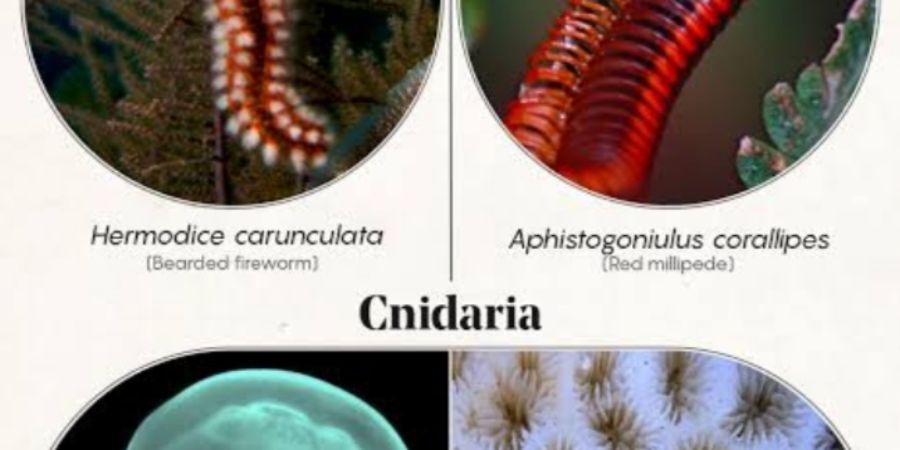

Phylum: Annelida. Class: Polychaeta. Order: Errantia. Example: Nereis. is a marine burrowing animal, occurs in sandy sea shore, rock crevices, but most of the time it lives in a ‘U’ shaped burrow of 200 meters depth.
It is commonly called ‘Sand Worm’ or ‘Clam Worm’.
Body is elongated; slender, bilaterally symmetrical and metamerically segmented consists of head, trunk and pygidium.
Head posses’ prostomium and ring like peristomium.
The prostomium contains 2 pairs of dorsal eyes, a pair each of sensory tentacles and palps.
Peristomium is large; it surrounds the ventral mouth and bears 4 pairs of dorsal tentacles.
Trunk is elongated and segmented; each segment bears laterally a pair of appendages called parapodia used for respiration and locomotion.
Pygidium is the lost segment, parapodia absent, it posses terminal anus and a pair of long anal cirri.
Phylum: Annelida. Class: Oligochaeta. Order: Neo-Oligochaeta. Example: Pheritima
Pheritima is a burrowing animal found in moist soil, lawns and gardens.
Body is elongated, cylindrical, brown colored and consists of 100 to 120 ring like segments.
Anterior end is narrow and pointed, while posterior end is blunt.
Mouth is crescentic lies just ventral to the prostomium.
Last body segment is the anal segment containing a terminal anus.
Except the prostomium and anal segment, the remaining body segments bears ring like locomotory setae.
Clitellum is a swollen ring like structure formed by the thickening of the segments 14, 15 and 16.
Hermaphroditic animal, reproduction is usually sexual type, and cross fertilization is a rule.
Female genital pore is lies ventrally in the 14th segment.
Paired male genital pore is situated ventrally on the 18th segment.
Two pairs of genital papillae found ventrally, one pair each in the segments 17th and 19th.
Earth worm is economically important it is used as fishing bait, educational and experimental purpose.
It is a friend of former; because it produces a very good fertilizer in the form of vermicompost, hence it is beneficial to agriculture.
Phylum: Annelida. Class: Hirudinea. Order: Gnathobdellida. Example: Leech.
Hirudinaria granulosa is a sanguivorous and ectoparasitic animal, commonly known as “Indian cattle leech”, occurs in fresh water ponds, lakes, streams etc.
Body is elongated, dorso-ventrally flattened and divided metamerically into 33 segments.
Each segment is further divided into rings or annuli.
Anterior sucker is oval bearing triradiate mouth with teeth.
Posterior sucker is circular and highly muscular used for adhesion and locomotion.
Antero-dorsal 5 segments bear 5 pairs of eyes.
Anus is mid-ventrally placed on the 25th segment.
17 pairs of nephridia found arranged from 6th to 22nd segments and are opens ventrally in the nephridiopores.
Hermaphroditic animal, male genital aperture is situated ventrally in the annulus of 10th segment while female genital aperture on the second annulus of 11th segment.
Reproduction is sexual type and cross fertilization is a rule.
Its food mainly consists of blood of sheep and other vertebrates.
On the lateral side, the section extends in parapodia.
Dorsal blood vessel, ventral blood vessel and double ventral nerve cord are present.


